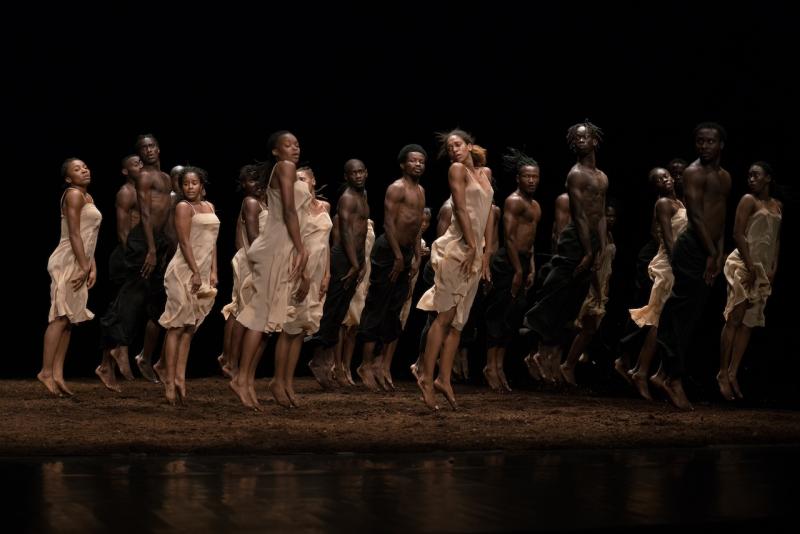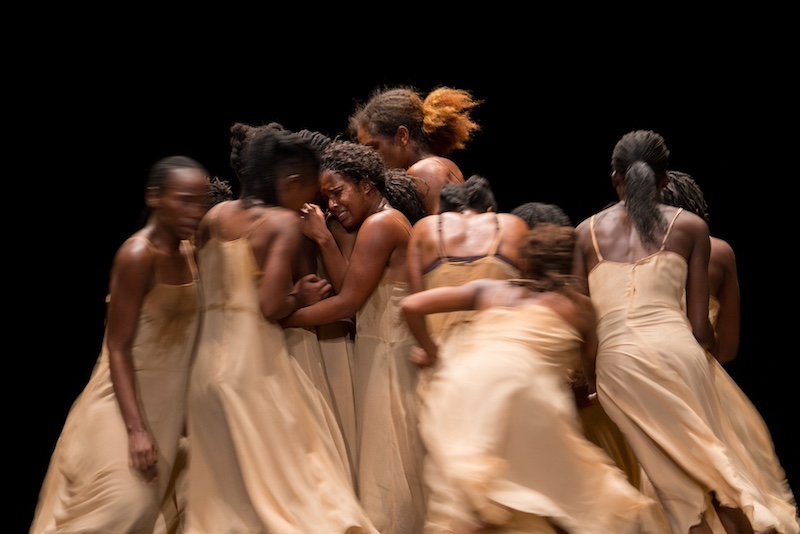Pina Bausch’s The Rite of Spring/common ground[s], Sadler’s Wells review - raw and devastating | reviews, news & interviews
Pina Bausch’s The Rite of Spring/common ground[s], Sadler’s Wells review - raw and devastating
Pina Bausch’s The Rite of Spring/common ground[s], Sadler’s Wells review - raw and devastating
Returning dancers from 13 African countries deliver celebrated vision with blistering force

It takes a lot to make an audience not want to head to the bar at the interval. But the preparation of the stage floor for The Rite of Spring in the version by Pina Bausch is a piece of theatre in itself, and many at Sadler’s Wells couldn’t tear themselves away.
 Running and leaping on a hard floor is one thing, but Bausch requires it to happen on a thick carpet of soft, crumbly peat. It takes 10 stagehands a full 30 minutes to cover the Sadler’s stage with 3060kg of the stuff, first taking up the floor covering of the previous piece, then laying down a brown undersheet which they hammer to a wooden frame. The soil is then barrowed into place and raked to a meticulous even flatness. Within minutes of the strangulated bassoon opening of Stravinsky’s score (relayed in an uncredited recording by an uncredited orchestra), that flat surface is rutted and scarred, scuffed up by the urgent landings and trampling of 34 pairs of feet.
Running and leaping on a hard floor is one thing, but Bausch requires it to happen on a thick carpet of soft, crumbly peat. It takes 10 stagehands a full 30 minutes to cover the Sadler’s stage with 3060kg of the stuff, first taking up the floor covering of the previous piece, then laying down a brown undersheet which they hammer to a wooden frame. The soil is then barrowed into place and raked to a meticulous even flatness. Within minutes of the strangulated bassoon opening of Stravinsky’s score (relayed in an uncredited recording by an uncredited orchestra), that flat surface is rutted and scarred, scuffed up by the urgent landings and trampling of 34 pairs of feet.
Where Kenneth MacMillan’s version of Rite channeled elements of the 1913 original staging, which depicted a prehistoric society of fearful tribespeople and their overlords, Bausch’s is all about pack mentality. A human sacrifice is required at the turn of the seasons to make the crops grow. It’s a personal honour that few dare to dream of, yet it’s also terrifying, as Bausch’s choreography makes clear as individual young women break free from their huddle to pick up then nervously reject the scarlet dress that signifies victimhood. The dance also makes clear the tribal groupthink – the acceptance that sacrifice is inevitable, that one life must end to enable life for all. Quite how mere choreography can achieve this is hard to credit. Technically, the movement comprises just a handful of motifs which gain force from being synchronised en masse – and repeated with a desperate feral energy. There’s a two-handed chop, a splay-legged bounce, a slap of the haunches and – now and again – a lyrical port de bras and pas-de-chat so beautiful that it startles.
A phalanx of women (pictured above), then of men, work these motifs in great surging diagonals across the space, the momentum matching Stravinsky’s blow for blow. When the Chosen One finally accepts her destiny and begins her solitary dance to death, the 33 others stand stock still and stare, aghast yet profoundly excited, as we the audience are too. My own feeling when the ordeal is finally over – and this happens every time I see this piece – are complicated. Horror and shame play no small part in it. I feel somehow that I shouldn’t be watching, and I’m convinced that Pina Bausch knew this when she made the piece. Nothing in her work happens by chance.
![photo: Maarten Vanden Abeele Germaine Acogny and Malou Airaudo in common ground[s]](/sites/default/files/images/stories/DANCE/Jenny_Gilbert/Pina%20Bausch_Germaine%20Acogny%20%26%20Malou%20Airaudo%2C%20common-ground%5Bs%5D%2C%20image%20credits%20Maarten%20Vanden%20Abeele%20%282%29.jpg) The opposite seemed to be true of the preceding common ground[s], a recent duet made as a companion piece to Rite. The work draws on the relationship between the two dance veterans who together mounted the pan-African production. Malou Airaudo (Western and white) and Germaine Acogny (African and black) had not previously met, but developed a strong bond – over-emphasised in this self-devised piece by an awful lot of hugging. More telling were such moments as when the pair sat on low stools with their backs to us watching a Senegalese sunrise (which was surprisingly easy to imagine). At 78 and 80 years of age, these women (pictured above) were obviously not going to give us gymnastics, but posing for endless minutes with each holding the end of a long pole was at once dull and obscure: the precise opposite of what followed in The Rite of Spring. The score by Fabric Bouillon LaForest for string quartet and keyboard was lovely, though, finding suggestions of African sonorities and textures in a classically Western frame. Happily, the programme remembered to name-check the musicians in this instance.
The opposite seemed to be true of the preceding common ground[s], a recent duet made as a companion piece to Rite. The work draws on the relationship between the two dance veterans who together mounted the pan-African production. Malou Airaudo (Western and white) and Germaine Acogny (African and black) had not previously met, but developed a strong bond – over-emphasised in this self-devised piece by an awful lot of hugging. More telling were such moments as when the pair sat on low stools with their backs to us watching a Senegalese sunrise (which was surprisingly easy to imagine). At 78 and 80 years of age, these women (pictured above) were obviously not going to give us gymnastics, but posing for endless minutes with each holding the end of a long pole was at once dull and obscure: the precise opposite of what followed in The Rite of Spring. The score by Fabric Bouillon LaForest for string quartet and keyboard was lovely, though, finding suggestions of African sonorities and textures in a classically Western frame. Happily, the programme remembered to name-check the musicians in this instance.
- The Rite of Spring / common ground[s] continues at Sadler’s Wells tonight and tomorrow, returns only
- Dancing at Dusk, a film made in 2020 of an outdoor dress-rehearsal of this production of Rite, is available to watch for free on Sadler’s Wells Digital Stage until 29 November
- Breath (Atem) is a sound installation offering a new perspective on The Rite of Spring via the sound of the dancers’ movements. 10 November throughout the afternoon, returns only
- More dance reviews on theartsdesk
rating
Explore topics
Share this article
The future of Arts Journalism
You can stop theartsdesk.com closing!
We urgently need financing to survive. Our fundraising drive has thus far raised £49,000 but we need to reach £100,000 or we will be forced to close. Please contribute here: https://gofund.me/c3f6033d
And if you can forward this information to anyone who might assist, we’d be grateful.

Subscribe to theartsdesk.com
Thank you for continuing to read our work on theartsdesk.com. For unlimited access to every article in its entirety, including our archive of more than 15,000 pieces, we're asking for £5 per month or £40 per year. We feel it's a very good deal, and hope you do too.
To take a subscription now simply click here.
And if you're looking for that extra gift for a friend or family member, why not treat them to a theartsdesk.com gift subscription?
more Dance
 'We are bowled over!' Thank you for your messages of love and support
Much-appreciated words of commendation from readers and the cultural community
'We are bowled over!' Thank you for your messages of love and support
Much-appreciated words of commendation from readers and the cultural community
 R:Evolution, English National Ballet, Sadler's Wells review - a vibrant survey of ballet in four acts
ENB set the bar high with this mixed bill, but they meet its challenges thrillingly
R:Evolution, English National Ballet, Sadler's Wells review - a vibrant survey of ballet in four acts
ENB set the bar high with this mixed bill, but they meet its challenges thrillingly
 Like Water for Chocolate, Royal Ballet review - splendid dancing and sets, but there's too much plot
Christopher Wheeldon's version looks great but is too muddling to connect with fully
Like Water for Chocolate, Royal Ballet review - splendid dancing and sets, but there's too much plot
Christopher Wheeldon's version looks great but is too muddling to connect with fully
 iD-Reloaded, Cirque Éloize, Marlowe Theatre, Canterbury review - attitude, energy and invention
A riotous blend of urban dance music, hip hop and contemporary circus
iD-Reloaded, Cirque Éloize, Marlowe Theatre, Canterbury review - attitude, energy and invention
A riotous blend of urban dance music, hip hop and contemporary circus
 How to be a Dancer in 72,000 Easy Lessons, Teaċ Daṁsa review - a riveting account of a life in dance
Michael Keegan-Dolan's unique hybrid of physical theatre and comic monologue
How to be a Dancer in 72,000 Easy Lessons, Teaċ Daṁsa review - a riveting account of a life in dance
Michael Keegan-Dolan's unique hybrid of physical theatre and comic monologue
 A Single Man, Linbury Theatre review - an anatomy of melancholy, with breaks in the clouds
Ed Watson and Jonathan Goddard are extraordinary in Jonathan Watkins' dance theatre adaptation of Isherwood's novel
A Single Man, Linbury Theatre review - an anatomy of melancholy, with breaks in the clouds
Ed Watson and Jonathan Goddard are extraordinary in Jonathan Watkins' dance theatre adaptation of Isherwood's novel
 Peaky Blinders: The Redemption of Thomas Shelby, Rambert, Sadler's Wells review - exciting dancing, if you can see it
Six TV series reduced to 100 minutes' dance time doesn't quite compute
Peaky Blinders: The Redemption of Thomas Shelby, Rambert, Sadler's Wells review - exciting dancing, if you can see it
Six TV series reduced to 100 minutes' dance time doesn't quite compute
 Giselle, National Ballet of Japan review - return of a classic, refreshed and impeccably danced
First visit by Miyako Yoshida's company leaves you wanting more
Giselle, National Ballet of Japan review - return of a classic, refreshed and impeccably danced
First visit by Miyako Yoshida's company leaves you wanting more
 Quadrophenia, Sadler's Wells review - missed opportunity to give new stage life to a Who classic
The brilliant cast need a tighter score and a stronger narrative
Quadrophenia, Sadler's Wells review - missed opportunity to give new stage life to a Who classic
The brilliant cast need a tighter score and a stronger narrative
 The Midnight Bell, Sadler's Wells review - a first reprise for one of Matthew Bourne's most compelling shows to date
The after-hours lives of the sad and lonely are drawn with compassion, originality and skill
The Midnight Bell, Sadler's Wells review - a first reprise for one of Matthew Bourne's most compelling shows to date
The after-hours lives of the sad and lonely are drawn with compassion, originality and skill
 Ballet to Broadway: Wheeldon Works, Royal Ballet review - the impressive range and reach of Christopher Wheeldon's craft
The title says it: as dancemaker, as creative magnet, the man clearly works his socks off
Ballet to Broadway: Wheeldon Works, Royal Ballet review - the impressive range and reach of Christopher Wheeldon's craft
The title says it: as dancemaker, as creative magnet, the man clearly works his socks off
 The Forsythe Programme, English National Ballet review - brains, beauty and bravura
Once again the veteran choreographer and maverick William Forsythe raises ENB's game
The Forsythe Programme, English National Ballet review - brains, beauty and bravura
Once again the veteran choreographer and maverick William Forsythe raises ENB's game

Add comment